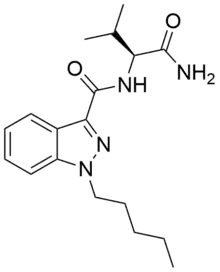AB-PINACA
AB-PINACA is a compound that was first identified as a component of synthetic cannabis products in Japan in 2012.[2]
 | |
| Legal status | |
|---|---|
| Legal status |
|
| Identifiers | |
| |
| CAS Number | |
| PubChem CID | |
| ChemSpider | |
| UNII | |
| CompTox Dashboard (EPA) | |
| Chemical and physical data | |
| Formula | C18H26N4O2 |
| Molar mass | 330.432 g·mol−1 |
| 3D model (JSmol) | |
| |
| |
It was originally developed by Pfizer in 2009 as an analgesic medication.[3][4]
AB-PINACA acts as a potent agonist for the CB1 receptor (Ki = 2.87 nM, EC50 = 1.2 nM) and CB2 receptor (Ki = 0.88 nM, EC50 = 2.5 nM) and fully substitutes for Δ9-THC in rat discrimination studies, while being 1.5x more potent.[5][6]
There have been a number of reported cases of deaths and hospitalizations in relation to this synthetic cannabinoid.[7][8]
Legal status
Singapore
It is listed in the Fifth Schedule of the Misuse of Drugs Act and so is illegal in Singapore, as of May 2015.[10]
United States
It is a Schedule I controlled substance in the United States.[11]
See also
References
- Anvisa (2023-07-24). "RDC Nº 804 - Listas de Substâncias Entorpecentes, Psicotrópicas, Precursoras e Outras sob Controle Especial" [Collegiate Board Resolution No. 804 - Lists of Narcotic, Psychotropic, Precursor, and Other Substances under Special Control] (in Brazilian Portuguese). Diário Oficial da União (published 2023-07-25). Archived from the original on 2023-08-27. Retrieved 2023-08-27.
- Uchiyama N, Matsuda S, Wakana D, Kikura-Hanajiri R, Goda Y (2012). "New cannabimimetic indazole derivatives, N-(1-amino-3-methyl-1-oxobutan-2-yl)-1-pentyl-1H-indazole-3-carboxamide (AB-PINACA) and N-(1-amino-3-methyl-1-oxobutan-2-yl)-1-(4-fluorobenzyl)-1H-indazole-3-carboxamide (AB-FUBINACA) identified as designer drugs in illegal products". Forensic Toxicology. 31: 93–100. doi:10.1007/s11419-012-0171-4. S2CID 25242453.
- "AB-PINACA". Cayman Chemical. Retrieved 25 June 2015.
- WO 2009106980A, Buchler IP, Hayes MJ, Hegde SG, Hockerman SL, Jones DE, Kortum SW, Rico JG, Tenbrink RE, Wu KK, "Indazole derivatives", published 3 September 2009, assigned to Pfizer Inc.
- Banister SD, Moir M, Stuart J, Kevin RC, Wood KE, Longworth M, et al. (September 2015). "Pharmacology of Indole and Indazole Synthetic Cannabinoid Designer Drugs AB-FUBINACA, ADB-FUBINACA, AB-PINACA, ADB-PINACA, 5F-AB-PINACA, 5F-ADB-PINACA, ADBICA, and 5F-ADBICA". ACS Chemical Neuroscience. 6 (9): 1546–1559. doi:10.1021/acschemneuro.5b00112. PMID 26134475.
- Wiley JL, Marusich JA, Lefever TW, Antonazzo KR, Wallgren MT, Cortes RA, et al. (September 2015). "AB-CHMINACA, AB-PINACA, and FUBIMINA: Affinity and Potency of Novel Synthetic Cannabinoids in Producing Δ9-Tetrahydrocannabinol-Like Effects in Mice". The Journal of Pharmacology and Experimental Therapeutics. 354 (3): 328–339. doi:10.1124/jpet.115.225326. PMC 4538877. PMID 26105953.
- Trecki J, Gerona RR, Schwartz MD (July 2015). "Synthetic Cannabinoid-Related Illnesses and Deaths". The New England Journal of Medicine. 373 (2): 103–107. doi:10.1056/NEJMp1505328. PMID 26154784.
- Thornton SL, Akpunonu P, Glauner K, Hoehn KS, Gerona R (September 2015). "Unintentional Pediatric Exposure to a Synthetic Cannabinoid (AB-PINACA) Resulting in Coma and Intubation". Annals of Emergency Medicine. 66 (3): 343–344. doi:10.1016/j.annemergmed.2015.05.021. PMID 26304261.
- "Gesetz über den Verkehr mit Betäubungsmitteln (Betäubungsmittelgesetz - BtMG) Anlage II (zu § 1 Abs. 1) (verkehrsfähige, aber nicht verschreibungsfähige Betäubungsmittel)" [Law on the Traffic in Narcotic Substances (Narcotics Act - BtMG) Annex II (to Section 1 Paragraph 1) (marketable but not prescription narcotics)]. Retrieved 22 June 2015.
- "Misuse of Drugs Act". Central Narcotics Bureau (CNB). 30 April 2015. Archived from the original on 15 July 2015. Retrieved 24 July 2015.
- "Schedules of controlled substances: Temporary placement of three synthetic cannabinoids into schedule I. Final order" (PDF). Drug Enforcement Administration, U.S. Department of Justice. 30 January 2015. Retrieved 9 July 2015.
- "关于印发《非药用类麻醉药品和精神药品列管办法》的通知" [Notice on Issuing the Measures for the Listing and Control of Non-Medicinal Narcotic Drugs and Psychotropic Substances] (in Chinese). China Food and Drug Administration. 27 September 2015. Archived from the original on 1 October 2015. Retrieved 1 October 2015.
- "Arrêté du 31 mars 2017 modifiant l'arrêté du 22 février 1990 fixant la liste des substances classées comme stupéfiants" [Order of March 31, 2017 amending the order of February 22, 1990 establishing the list of substances classified as narcotics] (in French). Legifrance. 6 April 2017. Retrieved 6 April 2017.
This article is issued from Wikipedia. The text is licensed under Creative Commons - Attribution - Sharealike. Additional terms may apply for the media files.